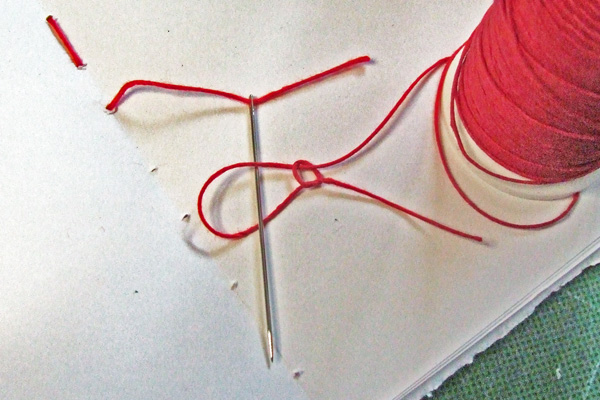
Sailors are familiar with the sheet bend [124743] ~ a quick and easy method of joining two ropes which is secure enough for their purposes. Bookbinders use the same knot, although some of them may not realize it ~ and the weaver's way of tying it* is probably completely different from the sailor's ~ and the bookbinder's method (described here) is different yet again.
Once tied the sheet bend must remain under constant slight tension if it is to remain successful. Both weavers and bookcrafters appreciate that ~ it is what they need for joining threads. The technique involves lassooing that short end of "old" thread.
The method shown below is especially useful in bookcrafts since the "almost finished" thread length can be left quite short, as usually happens in practice ~ try not to waste thread!. This "old" thread plays a small and passive part in the knot formation. This method also has the advantage that the knot can be tied very close to the working part of the "old" thread.
The start of the knot is shown below. The "old" thread is still threaded through the eye of the needle, and the shaft of the needle lies through the noose of a simple slip knot tied in the "new" thread.

Whilst the "old" thread still in the needle the needle is passed through the loop of a slip knot made at the end of the "new" thread. The slip knot is being used to lassoo the "old" thread, and is gradually tightened. At the same time it is slid as far towards the last hole used by the "old" thread as possible. It is quite tricky to maintain the right tensions in the various threads as the knot is tied ~ the very final tug will change the character of the knot and make it very difficult to undo. It no longer has any slip-knot characteristics

When the slip knot is considered close enough to the paper, the hold on the "old" thread can be released ~ as the new thread and slip knot is tightened a little more.

The next stage involves changing finger grips from that shown above. Leave the "old" thread alone and pinch the loose end of the "new" thread with the fingers of one hand. The picture below shows the "new" thread being held. Hold the working end ~ the spool ~ of the "new" thread with the other hand (not shown in the picture ~ I need one hand for the camera).
A gentle pull on the short and long ends of the "new" thread will cause the noose to choke the "old" thread, pulling it through the noose in such a way that it is unlikely ever to come undone. If your tensions are just right ~ and ears and fingertips finely tuned ~ you can almost feel or hear a click as the old thread is pulled through the noose and securely grabbed tight.
Ideally it looks best if the knot can end up centrally between the two holes. Snip the two ends to be 5mm long ~ and the job is done. The picture, below shows the knot ~ finally tied ~ and rather too close to the original hole.

It is not possible to see the finished result in close-up with this, an actual working example. I am preparing a demonstration in more detail should you wish to clarify matters by seeing it in greater close up. Or better still - go and experiment! There is also guidance on tying a simple slip knot [127300].
*The method used by weavers to tie their knot is quite different. It involves wrapping threads around two fingers of one hand ~ as if knitting needles ~ and a quick jiggle with the other. I have seen it demonstrated, but it would need a slow-motion camera to usefully record it. No doubt weavers are able to tie the knot in milliseconds, and with their eyes closed. Stopping a loom costs money! Please let me know if you can amplify this, preferably with very much slowed-down pictures. It may be a skill that is being lost to future generations.
I am not a sailor. I am sure they also will have one handed ~ different ~ but very quick ways of tying sheet bends whilst holding on to the rigging with the other hand ~ blinded by the spray ~ in a typhoon. (I believe the sheet bend is used for reefing the sails ~ which I assume is normally done before the storm strikes.)
